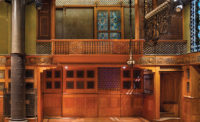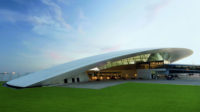The Park Avenue Armory has long been a New York powerhouse. The 1881 behemoth was built for the Seventh Regiment of the National Guard with money donated by the city’s resident elite. Today the armory is a bastion of creative strength: as a venue for art and performances; subject of an ongoing restoration led by Herzog & de Meuron; and, later this spring, Rafael Viñoly’s laboratory.
On April 30 Artvest Partners will launch Spring Masters New York, a fair for art produced between antiquity and the 20th century, which corresponds with Christie’s and Sotheby’s signature Impressionism and modern art auctions. Installed inside the Park Avenue Armory’s 55,000-square-foot drill hall, Spring Masters also introduces an exhibition scheme by Viñoly that challenges fairs’ status-quo rectangular grids.
Instead of placing exhibitors within cubicle spaces—which produces “very little excitement as a journey,” Viñoly says—the architect has conceived a hexagonal booth. The six-sided modules increase average area and linear footage for presentation, and enhance gallerists’ views to the corridor, says Artvest principal Jeff Rabin. Viñoly adds that the booths’ corresponding plan yields “a more articulated path that encourages discovery. It also creates facades for the booths, which provides for a much more exciting public space.”
Approximately 59 gallerists are expected to occupy single- and double-booth setups. Meanwhile, interior designer Diana Viñoly, Rafael’s wife, is ensuring continuity among the booths’ outward-facing planes, and drawing connections between the overall interior experience and Park Avenue’s famous springtime display of tulips.
Rabin’s partner Michael Plummer says of the redesign efforts, “We are creating a new luxury event.” Yet the exhibition setup keeps an eye firmly on budget: Hexagons are assembled from standard-issue cubicle panels. Plummer also notes that the Viñolys’ undertakings align Spring Masters to the European practice of presenting traditional art in a contemporary context. Of the frisson between eras, he says, “The contemporary makes the traditional more exciting and relevant, and the traditional lends context to the contemporary.” While Viñoly says that his hexagonal forms do recall Archigram’s triangular grids that inspired him as an architecture student, the Armory design is more sympathetic to the distant past than observers may catch on. “If you look at the history of markets and souks, the most interesting ones are the ones that do more than pack units together.”











Post a comment to this article
Report Abusive Comment